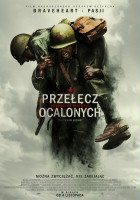Przełęcz ocalonych
Hacksaw Ridge
2016
- podstawowe informacje
- Opinie i Nagrody
- multimedia
- pozostałe
powrót do forum filmu Przełęcz ocalonych
Nie podoba mi się w tym filmie, to że prawdopodobnie cała ta scena batalistyczna wcale się nie wydarzyła. Przyznam, że jedyny dowód na to jaki znalazłem to opis z anglojęzycznej wikipedi, gdzie jest napisane, że dostał ten Medal Honoru za 3 tygodnie służby, a nie za tę jedną akcję. Do tego jest tam cała masa sytuacji, które z militarnego punktu widzenia były bez sensu, ale nie chcę się rozwodzić nad tym, bo nikt tego nie przeczyta.
Zmierzam do tego, że istnieje szansa, że gość był po prostu sanitariuszem, na pewno był odważny, ale mógł ten medal dostać głównie dlatego, że wszyscy go rozpoznawali bo nie miał broni i to już była wielka odwaga, a to że taki religijny gość dostał medal to już wchodzi w to polityka.
A jeśli było tak jak piszę to cały ten film jako taka laurka, w stylu średniowiecznych eposów jest kompletnie bez sensu.
"Do tego jest tam cała masa sytuacji, które z militarnego punktu widzenia były bez sensu, ale nie chcę się rozwodzić nad tym, bo nikt tego nie przeczyta"
No ja właśnie szukam takiej analizy (jak przy każdym filmie wojenny). Jeśli chcesz się jeszcze kiedyś pokusić o "rozwodzenie" to chętnie przeczytam ;)
Rząd Stanów Zjednoczonych wzniósł po wojnie dwa pomniki na szczycie urwiska. Jedna tablica jest w języku angielskim, druga w japońskim. Oryginalne tablice z brązu zostały później skradzione. Zastąpiono je tablicami marmurowymi.
„Szer. Desmond T. Doss, adwentysta dnia siódmego, sanitariusz 77 dywizji piechoty, otrzymał Honorowy Order Kongresu za zasługi w bitwie o Urwisko Maeda. Szeregowy Doss pozostał na szczycie urwiska, gdy jego oddział już został wycofany, po to, by ratować rannych, i wyniósł 75 z nich na brzeg urwiska, po czym opuścił w dół na linie.”
Tu masz notkę z odznaczenia:
"Medal of Honor
Rank and organization: Private First Class, United States Army, Medical Detachment, 307th Infantry, 77th Infantry Division.
Place and date: Near Urasoe Mura, Okinawa, Ryukyu Islands, April 29, 1945 – May 21, 1945.
Entered service at: Lynchburg, Virginia
Birth: Lynchburg, Virginia
G.O. No.: 97, November 1, 1945.
Corporal Doss receiving the Medal of Honor from President Harry S. Truman on October 12, 1945
The President of the United States of America, authorized by Act of Congress, March 3, 1863, has awarded in the name of The Congress the MEDAL OF HONOR to
PRIVATE FIRST CLASS DESMOND T. DOSS
UNITED STATES ARMY
for service as set forth in the following
Citation: Private First Class Desmond T. Doss, United States Army, Medical Detachment, 307th Infantry, 77th Infantry Division. Near Urasoe-Mura, Okinawa, Ryukyu Islands, 29 April – 21 May 1945. He was a company aid man when the 1st Battalion assaulted a jagged escarpment 400 feet high. As our troops gained the summit, a heavy concentration of artillery, mortar and machinegun fire crashed into them, inflicting approximately 75 casualties and driving the others back. Private First Class Doss refused to seek cover and remained in the fire-swept area with the many stricken, carrying them one by one to the edge of the escarpment and there lowering them on a rope-supported litter down the face of a cliff to friendly hands. On 2 May, he exposed himself to heavy rifle and mortar fire in rescuing a wounded man 200 yards forward of the lines on the same escarpment; and two days later he treated four men who had been cut down while assaulting a strongly defended cave, advancing through a shower of grenades to within eight yards of enemy forces in a cave's mouth, where he dressed his comrades' wounds before making four separate trips under fire to evacuate them to safety. On 5 May, he unhesitatingly braved enemy shelling and small arms fire to assist an artillery officer. He applied bandages, moved his patient to a spot that offered protection from small-arms fire and, while artillery and mortar shells fell close by, painstakingly administered plasma. Later that day, when an American was severely wounded by fire from a cave, Private First Class Doss crawled to him where he had fallen 25 feet from the enemy position, rendered aid, and carried him 100 yards to safety while continually exposed to enemy fire. On 21 May, in a night attack on high ground near Shuri, he remained in exposed territory while the rest of his company took cover, fearlessly risking the chance that he would be mistaken for an infiltrating Japanese and giving aid to the injured until he was himself seriously wounded in the legs by the explosion of a grenade. Rather than call another aid man from cover, he cared for his own injuries and waited five hours before litter bearers reached him and started carrying him to cover. The trio was caught in an enemy tank attack and Private First Class Doss, seeing a more critically wounded man nearby, crawled off the litter and directed the bearers to give their first attention to the other man. Awaiting the litter bearers' return, he was again struck, this time suffering a compound fracture of one arm. With magnificent fortitude he bound a rifle stock to his shattered arm as a splint and then crawled 300 yards over rough terrain to the aid station. Through his outstanding bravery and unflinching determination in the face of desperately dangerous conditions Private First Class Doss saved the lives of many soldiers. His name became a symbol throughout the 77th Infantry Division for outstanding gallantry far above and beyond the call of duty.
Harry S/ Truman
October 12, 1945
THE WHITE HOUSE"




